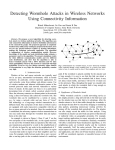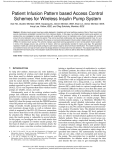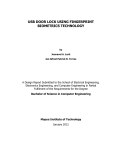Download A Wireless Sensor Networks Test-bed for the Wormhole Attack
Transcript
International Journal of Digital Content Technology and its Applications Volume 3, Number 3, September 2009 A Wireless Sensor Networks Test-bed for the Wormhole Attack Hani Alzaid1,2 and Suhail Abanmi3 1 Information Security Institute, Queensland University of Technology Brisbane QLD 4000, Australia 2 Computer Research Institute, King Abdulaziz City for Science and Technology Riyadh, Saudi Arabia [email protected] 3 Computer Science College, University of New South Wales Sydney NSW 2052, Australia doi: 10.4156/jdcta.vol3.issue3.2 Abstract program space, 1024 KB external flash, and is powered by two AA batteries [3]. Also, the processing capabilities in sensor nodes are generally not as powerful as those in the nodes of wired networks. Complex cryptographic algorithms consequently are impractical for WSNs. Not only resource limitations affect the WSN’s performance but also the nature of deployment affects this performance [1]. Most WSNs are deployed in remote or hostile environments where nodes are exposed to physical attacks. This is because anyone can access the deployment area and these sensors lack tamper-resistance property. WSNs are vulnerable to several attacks. One major attack is known as a wormhole attack where an attacker records a packet at one location in the network, tunnels the packet to another location, and then replays it at another part of the network. The wormhole attack places the attacker in a very powerful position, allowing him to gain unauthorized access, disrupt routing, or perform a Denial-of-Service (DoS) attack [6,7]. Current solutions for wormhole attacks, such as [10, 15, 16], are evaluated by running the proposed techniques in different simulations. There is no real deployment for any of these solutions. In this article, a common ground or real deployment is built in order to compare different solutions designed for protecting the network against wormhole attacks. To the best of our knowledge, the crisp implementation of the wormhole attack in WSNs has not appeared in print before. BANAID consists of a few In some applications, wireless sensor devices must be secured, especially when the captured information is valuable and sensitive. The wormhole attack is a significant type of security attack that can damage wireless sensor networks if they go undetected. It occurs when the attacker records packets at one point of the network, and then passes them into a different node. This node then injects the packets into the network again. In this tutorial article, an actual test bed called BANAID. It describes a simulated wormhole attack against wireless sensor networks. In addition, a recently developed solution against this attack is implemented. Keywords Wireless Sensor Networks, Wormhole Attacks, and Test-beds. 1. Introduction Wireless Sensor Networks (WSNs) are highly distributed networks of small, lightweight wireless nodes. They are deployed in large numbers to monitor the environment or other systems through the measurement of physical parameters such as temperature, pressure, or relative humidity [13, p 647]. Recently, WSNs have been used in many promising applications including habitat monitoring [11], military target tracking [8], natural disaster relief [2], and health monitoring [12]. However, WSNs are resource constrained with a limited energy lifetime, slow computation, small memory, and limited communication capabilities [17]. The current version of sensor nodes such as mica2 uses a 16 bit, 8MHz Texas Instruments MSP430 micro-controller with only 10 KB RAM, 48KB 19 A Wireless Sensor Networks Test-bed for the Wormhole Attack Hani Alzaid and Suhail Abanmi Figure 1. MICA2 mote without an antenna [4]. Figure 2. MIB510 Serial Interface Board [4]. numbers of Mica2 [4] and two Stargate [5] sensor devices. Moreover, one of the current solutions, which is Packet Leashes [9], is implemented in this article. The preliminary version of this article was presented at the AusCERT’08 conference [18,19]. The rest of the article is organized as follows. In Section 2, an introduction about different components used in building up BANAID is given. Section 3 describes the designing phase and the implementation phase of BANAID. Section 4 concludes the article. compatible and can communicate with each other. (The x = 0, 1, or 2 depending on the type / frequency band) [4]. Figure 1 shows a sample of MICA2 mote. The current version of Mica2 uses a 16 bit, 8MHz Texas Instruments, 1024 KB external flash, and is powered by two AA batteries. 2.1.2 Hardware Layout The MICA2 mote can be reprogrammed using an external board called MIB510 Serial Interface Board. This board is a multi-purpose interface board used with MICA, MICA2, MICAz, and MICA2DOT motes family. It supplies power to the devices through an external power adapter option, and provides an interface for a RS-232 mote serial port and reprogramming port [4]. The MIB510 serial interface board, as shown in Figure 2, is used to program the MICA2 mote. This board has the PC connection capability using the RS-232 serial port. Programming the motes requires a special operating system called TinyOS 1, which should be installed in the PC. 2. BANAID Components It is important to have some background about these wireless sensor devices that are used in this article to build up the test bed. BANAID consists of several Mica2 motes and two Stargate sensor devices. In the following sections, a brief information about these two types of wireless devices is given. 2.1 MICA2 There are different models of motes that have been produced by Crossbow. Each of these models has different features. These models are MICAz, MICA2, MICA2DOT, and MICA. In this article, MICA2 is the focus and is used to build BANAID. The features, hardware layouts, and software environment of MICA2 motes are described in the following sections. 2.1.3 Software Environment MICA2 motes use a special operating system called TinyOS, which is used for wireless sensor nodes. This operating system is an open-source event-driven operating system designed for wireless embedded sensor networks. It features a component based architecture which enables rapid innovation and implementation while minimizing code size as required by severe memory constraints inherent in sensor networks. TinyOS’s component library includes network protocols, distributed services, sensor drivers, and data acquisition tools – all of which can be used as-is or can be further refined for a customized application. TinyOS’s event-driven execution model 2.1.1 MICA2 Features The MICA2 motes come in three types according to the RF frequency bands: MPR400 (915 MHz), MPR410 (433 MHz), and MPR420 (315 MHz). The motes use the Chipcon CC1000, FSK modulated radio. All types utilize a powerful Atmega128L microcontroller and a frequency tunable radio with extended range. The MPR4x0 and MPR5x0 radios are 1 20 TinyOS website http://www.tinyos.net/ International Journal of Digital Content Technology and its Applications Volume 3, Number 3, September 2009 enables fine-grained power management, yet allows the scheduling a WiFi Compact Flash card. Another expansion in Stargate is MICA2 mote connector. It allows the Figure 4. Processor Board (Bottom View) [5]. Figure 3. Processor Board (Top View) [5]. Stargate to communicate wirelessly with other MICA2 motes. Stargate consists of two hardware pieces: the processor board and the daughter card. These pieces are explained in details in the following subsection. flexibility made necessary by the unpredictable nature of wireless communication and physical world interfaces [4]. TinyOS have been implemented in a language called nesC 2 . This language is an extension to C language which has been designed to embody the structuring concepts and execution model of TinyOS. Programs written in nesC language are built out of components, which are wired to form entire programs. Each component has interfaces which can provide its functionality to other users. 2.2.2 Hardware Layout As mentioned previously, Stargate consists of two hardware pieces: a processor board and a daughter board. Each of these pieces is described in this subsection. Figure 3 shows the top view of the processing board. It is clear from this view that Stargate has two slots. These slots can be used to communicate with other devices. The first slot is used to allow Stargate to communicate with another MICA2 mote. The second slot is used to connect WiFi Compact Flash card to the Stargate, which allows it to communicate through the standard 802.11a or 802.11b wireless protocols. The processor board gets its power from the daughter card. The daughter card has a power supply jack as it appears in Figure 5 and Figure 6. Also, the daughter card allows the user to communicate with Stargate using different types of interfaces. There are three different ways to communicate with Stargate: Serial RS232 Connector, RJ-45 Ethernet Port, and USB Port. All these interfaces give the ability to control or upload programs to the Stargate. All switch buttons in the Stargate processor board and daughter card have to be switched on before using Stargate. There are two switch buttons (S1 and S2) in the processor board and the third switch button S3 is located in the daughter card. 2.2 Stargate Stargate is a powerful single board computer with enhanced communications and sensor signal processing capabilities. This product was designed within Intel’s Ubiquitous Computing Research Program, and licensed to Crossbow for production. In addition to traditional single board computer applications, the Stargate directly supports applications around Intel’s Open-Source Robotics initiative as well as TinyOS based Wireless Sensor Networks. 2.2.1 Stargate Features Stargate uses Intel’s latest generation 400 MHz XScale processor (PXA255) and SA1111 StrongARM companion chip for I/O access. It has a reset button, real time clock, lithium ion battery option and 51-pin daughter card interface [5]. The Stargate sensor device, which is used in this test bed, has various features and can be used in different applications. The main feature that has been used extensively in the test bed is the Compact Flash slot. Stargate has the capability to have 2.2.3 Software Environment As mentioned before, the Stargate uses an embedded Linux operating system kernel. It is installed 2 nesC: A Programming Language for Deeply Networked Systems http://nescc.sourceforge.net/ 21 A Wireless Sensor Networks Test-bed for the Wormhole Attack Hani Alzaid and Suhail Abanmi Each mote only forwards, without changing, any received message from radio connection to WiFi Figure 5. Daughter Card (Top View) [5]. Figure 7. The proposed designed of BANAID. connection and vice versa. The routing algorithm that has been used in BANAID is the Ad hoc On Demand Distance Vector (AODV). This routing algorithm is explained in the next subsection. The wormhole attack happens during the phase of building routes between nodes in AODV. The attack will affect the routing table entries in the original source and destination motes. Hence, the actual path that a message should pass from, the original source to the original destination, will be imprecise. The impact of the wormhole attack on the network will appear clearly in both the original source and the original destination motes. The original source mote will deal with the original destination mote as its direct neighbor, which is incorrect because they are separated by two intermediate motes. Figure 6. Daughter Card (bottom View) [5]. on the processing board of the Stargate. There is also additional software shipped with the Stargate development platform, which could be used to enable program development. The Stargate’s platform provides the capability of installing programs written in C language. The developer can control various functions in Stargate by using C language programs after compiling and installing them. 3. Building BANAID 3.2 The AODV Algorithm The design, implementation, explanation of the wormhole attack, and the implementation of its solution are described in this section. The Ad hoc On Demand Distance Vector (AODV) routing algorithm is a routing protocol designed for ad hoc mobile networks. It is an on demand algorithm, meaning that it builds routes between nodes only as required by source nodes. It maintains these routes as long as they are needed by the sources. AODV builds routes using route request and reply query messages. When a source node desires a route to a destination for which it does not already have a route, it broadcasts a route request (RREQ) packet across the network. Nodes receiving this packet update their information for the source node and set up backwards pointers to the source node in the route tables. A node receiving the RREQ may send a route reply (RREP) either if it is the destination or if it has a route to the destination and the sequence number in RREQ packet is fresh number (not seen before by the node). If this is the case, it sends a RREP back to the source. Otherwise, it forwards the RREQ. Nodes keep track of 3.1 Design of BANAID The proposed test bed is developed with the following underlying assumptions: • The chosen network’s topology is fixed. • Each node knows its neighbors. Figure 7 shows that BANAID is composed of seven Mica2 sensor nodes and two Stargate devices. In this network design, the original source is mote 1 and the original destination is mote 4. The global clock is a normal sensor node that keeps sending a clock packet to synchronize all other motes. 22 International Journal of Digital Content Technology and its Applications Volume 3, Number 3, September 2009 the RREQ’s packets by storing their sequence numbers. If they receive a RREQ which they have already processed, they discard the RREQ and they do not forward it. As the RREP is propagated back to the source node, these nodes set up forward pointers to the destination. Once the source node receives the RREP, it may begin to forward data packets to the destination. The routing table for each node is updated according to the hop count field in RREQ or RREP packets. The received packet with the smallest hop count will be chosen as the best route path. However, in this article, not all of AODV routing algorithm features have been implemented. Features that meet the scope of this article are just implemented for the sake of simplicity. For example, features like sending and receiving RREQ/RREP packets, and building the routing tables for each node have been implemented whereas features like maintaining the route paths and sending ‘hello’ messages have not been implemented. OS Table 1. Packet Format. C N HC MID MT S/T TS Table 2. Routing Table Format. Destination Address Node A … Next Hop Hop Count Node F … 3 … 3.3.1 The AODV Program Before describing the capabilities of this program, a brief explanation about the important variables is given. The packet format used in building the wormhole attack test bed is composed of the following fields (see Table 1): • OS represents the address of the original sender. • OD represents the address of the original destination. • C represents the address of the intermediate sensor node or current node that handles the current packet. • N represents the address of the next-hop sensor node. • HC represents the hop counter. • MID represents the messages ID. • MT represents the message type. • S/M explains whether the message comes from a Stargate or a Mica2 sensor. • TS represents time stamp. 3.3 Implementation of BANAID According to the proposed design of BANAID, there are seven MICA2 motes and two Stargate sensor devices. Two motes have been combined with two Stargate sensor devices which are mote 5 and mote 6. Details on the implementation settings can be found in [18]. To implement BANAID, three programs 3 have been written and installed in the motes and the Stargate sensor devices. The first program has been installed in motes 1, 2, 3, and 4, which is a simple customized AODV algorithm. The second program has been installed in motes 5 and 6, which forwards any received packet from the radio antenna to the serial port that connects the mote with the Stargate, without changing the received packet. The third program has been installed in both Stargate 1 and 2. When a packet is received by the Stargate from its serial port, which is connected to the corresponding mote, the program forwards it to the other Stargate through its WiFi connection. The other Stargate will receive this packet from its WiFi connection and forward it to its serial port, which is also connected to the corresponding mote. This packet then will be broadcasted via the radio antenna of the attached mote. 3 OD Next, Table 2 describes the routing table format. It is a k * 3 array where k is a predefined value that represents the maximum number of entries that the routing table can hold. The table consists of three fields: the destination address field which stores the final destination for the current received packet, the next hop field which holds the address for next hop, and the hop count field which represents the number of hops left before reaching the final destination. Algorithm 1 illustrates the pseudo code that is used in this article to implement AODV. It describes the AODV’s functionalities that have been implemented in order to build this test bed. It is the most important part of the test bed since it implements the AODV routing algorithm, synchronizes with the global clock, and implements the solution for the wormhole attack. This program has been written in combination of nesC and C languages and is upload into mote 1,2,3, and 4. These programs can be downloaded from http://www.wsn-security.info/BANAID.rar 23 A Wireless Sensor Networks Test-bed for the Wormhole Attack Hani Alzaid and Suhail Abanmi Algorithm 1: Simplified version of the AODV Program. /* Initialization phase */ 1: Synchronize internal clock with the global clock; 2: Send PKT; /* just for the source to start sending the packet*/ 3: if ( PKT_MSG_Type = 0 ) then /* RREQ Mode */ 4: { if ( PKT_MSG_ID is not in RREQ List ) then 5: { Add entry into Routing Table; 6: Add PKT_MSG_ID into RREQ List; 7: if ( PKT_Orig_Destin= Current_Mote_Address ) then 8: preparing RREP PKT and send it; 9: else forward PKT; 10: } 11: else { Check RT for PKT_Orig_Source and get the Hop_Count; 12: if ( Hop_Count > PKT_Hop_Count ) then 13: { update the entry in Routing Table; 14: Send PKT; 15: }}} 16: else if ( PKT_MSG_Type = 1 ) then /* RREP Packet */ 17: { 18: if ( PKT_MSG_ID is not in RREP List ) then 19: { Add an entry into my RT (Routing Table); 20: Add PKT_MSG_ID into RREP List; 21: if ( PKT_Orig_Destin= Current_Mote_Address ) then 22: { RREP PKT reach it’s destination; 23: send routing information for this mote; 24: } 25: else forward PKT; 26: } 27: else 28: { Check RT for PKT_Orig_Source and get the Hop_Count; 29: if ( Hop_Count > PKT_Hop_Count ) then 30: { update the entry in Routing Table; 31: Send PKT; 32: } 33: } 34: } 35: else if ( PKT_MSG_Type =2 ) then 36: { 37: if ( PKT_Orig_Destin =Current_Mote_Address ) then 38: packet reach its destination; 39: else 40: { 41: Check RT for PKT_Orig_Destin and get Next_Hop ; 42: Send PKT for the next hop; 43: } 44: } End; 3.3.2 TOSBase Program This program is delivered with the TinyOS tool kit as one of the many readymade applications. The name of this application is TOSBase, which can be found under the application directory in TinyOS file. It simply forwards any received packet from the radio antenna of the Mica2 sensor to the serial port (51-pin Hirose Connector), which is shown in Figure 1, without changing the content of the packet. The Mica2 sensor is connected to the Stargate through this serial port. This program is written in nesC language and is uploaded into mote 5, and 6 (see Figure 7). 3.3.3 Stargate Program The program consists of two threads or processes. The first process is the main program, which keeps listening to the serial port and sends any received packet to the client socket. The client socket will initiate a WiFi connection with the server socket in the other Stargate. The second thread or process runs as a server that keeps listening to any client connection via WiFi. It receives the packet and forwards it to the serial port connected to the mote, which will broadcast the packet via its radio antenna. As explained in Figure 9, the program in Stargate 1 only forwards messages received from the radio and comes from the original source which is mote 1. The other Stargate only forwards messages received from the radio that comes from mote 4 which is the original destination. The two versions of these programs are the same except in checking the message type before forwarding it. Algorithm 2: Stargate’s Program. /* Initialization phase */ /* */ 1: Open Serial port; /* The server runs forever to receive any MSG from Stargate 2 with IP: 10.1.1.3, and then forwards it to the serial port to be sent by a sensor node attached to it via radio */ 2: Run server thread with IP: 10.1.1.2; 3: While (1) do { 24 International Journal of Digital Content Technology and its Applications Volume 3, Number 3, September 2009 the request packet comes before the reply. However, if the yellow light has been seen before the green light, it means a wormhole attack has been detected. The reason for this is the replay comes before or faster than the request packet. By using these lights, it is easier now to understand what is happening during the demonstration. 4: If (Stargate receive a MSG from the serial) then /* the MSG comes from radio via mote 5 */ 5: { 6: If (the MSG comes from mote 1) then /* It is RREQ */ 7: { 8: Call client to forward MSG through WiFi to Stargate 2; 9: } 10: } 11: } 12: End. Algorithm 3: TOBase’s Program. /* Initialization phase /* 1: Event#1: if (Radio receive MSG) then 2: { 3: Call UARTSendTask to send MSG; /* It will send MSG to the serial port 4: } 5: Event#2: if (UART receive MSG) then 6: { 7: Call RadioSendTask to send MSG; /* It will send MSG to the radio 8: } 9: End. /* The second Stargate */ /* Initialization phase */ /* */ 1: Open Serial port; 2: Run server thread with IP: 10.1.1.3; /* The server runs forever to receive any MSG from Stargate 1 with IP: 10.1.1.2, and then forward it to the serial port to be sent by a sensor node attached to it via radio*/ 3: While (1) do { 4: If (Stargate receive a MSG from the serial) then /* the MSG comes from radio via mote 6 */ 5: { 6: If (the MSG comes from mote 4) then /* It is RREP */ 7: { 8: Call client to forward MSG through WiFi to Stargate 1; 9: } 10: } 11: } 12: End. */ */ */ */ 3.5 Visibility of BANAID There are two scenarios for the running of BANAID. The first scenario is demonstrating the customized AODV routing algorithm without implementing the wormhole attacks. In other words, this scenario demonstrates the customized AODV without the Stargate sensor devices. The second scenario demonstrates the wormhole attack within the customized AODV environments. To run the first scenario, it is important to turn the Stargate sensor devices off. The wormhole attack will not occur in this scenario. To start this demonstration, firstly turn on mote 2, 3, 4, and 7. Then, turn on mote 1 which acts as the original source. Mote 1 will start sending RREQ packet by blinking its green light. This sending will occur after global clock synchronization is accomplished. Mote 2 will receive the RREQ packet, turn on its red light, and forward this packet by blinking its green light. Mote 3 will do the same thing that mote 2 has done. Finally, mote 4 will receive the RREQ packet, turn on its red light and yellow light indicating that the RREQ has reached its destination, and prepare the RREP packet. The same process will happen for RREP packet, but the difference is that each mote will turn on its yellow light on receiving the RREP packet. Finally, Mote 1 will turn on its red and yellow lights on receiving the RREP packet indicating that the RREP has reached its destination. The other scenario is demonstrating the wormhole attack by adding the two Stargate devices with their 3.4 Demonstration of BANAID This section illustrates the usability of this test bed. The Mica2 motes have some indicators which have been used to simulate this type of attack. Each mote has three lights: red, green, and yellow. These lights have been used in this article to simplify the demonstration of BANAID by showing how packets are traveling from one mote to another and when the wormhole attack happens. For example, when the green light blinks, it means that the mote is sending a packet. The red light indicates that the mote has received a RREQ packet from the other motes. The yellow light turns on when the mote has received a RREP packet from the other motes. The green and yellow lights together indicate that a RREQ or RREP has been received at the destination. It is obvious that the red light will be seen before the yellow light since 25 A Wireless Sensor Networks Test-bed for the Wormhole Attack Hani Alzaid and Suhail Abanmi motes. Firstly, turn on all motes and Stargates except mote 1 which is the original source. Then, turn on mote 1 to start sending the RREQ packet. In this situation, mote 4 which is the original destination will receive the RREQ from mote 1 directly through the Stargate path since the WiFi path is faster than the radio path. This happens when Mote 5 receives the RREQ packet from mote 1 and sends it directly through the WiFi connection to the other Stargate. Mote 6 in the other Stargate will send this packet to mote 4 via its radio antenna. The RREQ packet will travel through the WiFi connection faster than the normal path which travels through motes 2 and 3. In this situation, mote 4 will think that mote 1 is its direct neighbor and it will turn on its red light and yellow light preparing for the RREP packet. Mote 4 will send the RREP packet and then the packet will be delivered through the WiFi connection between the two Stargates. Mote 1 will turn on its red and yellow lights when it receives the RREP packet. Also, mote 1 will think that mote 4 is its direct neighbor and this is how the wormhole attack happens. It is possible to display the information of the packets and the final routing table in mote 1 by using a PC. There are a number of techniques to solve the wormhole attack in wireless sensor networks. In the next section, some of these techniques are briefly described. The implementation of one of them is explained in section 3.7. value in the packet. Therefore, the receiver will be able to detect if the packet traveled so fast according to a specified transmission time. In BANAID, the temporal leash solution has been used and implemented to detect and prevent the wormhole attack in the wireless sensor network. The geographic leash solution has not been considered in this article because it needs a special hardware that can specify the locations of all nodes such as GPS, which is expensive. 3.7 Implementation of the Packet Leashes Solution As it has been discussed earlier, timing mechanism is required to distinguish if the packet received from the fake path or the real path to avoid the wormhole attack. A packet received from the Stargate is going to be faster than the packet received from the mote since the WiFi transmission is faster than the radio transmission. Therefore, applying this timing mechanism allows the destination to recognize the real packet by comparing it’s time stamp with the time stamp of the received packet. If the difference between these two time stamps is less than or equal to a predefined value (threshold), it means that it is a fake packet. To compute the value of this threshold according to BANAID design, we performed the following: 3.6 Wormhole Attack Solution • There is a transmission delay in each mote. The average transmission delay is around 45 msec ( Tr = 45 msec ) [14]. • The real path consists of four sensor nodes (N = 4), which are mote 1, 2, 3, and 4. On the other hand, the fake path consists of four sensor nodes, which are motes 1, 5, 6, and 4, but only two sensor nodes will participate in the transmission activities (N = 2). These two nodes are mote 1, and mote 6. • Processing time at each mote is neglected since both paths have the same number of motes. Therefore, the total processing time for motes in each path is almost same. • The WiFi transmission delay is neglected since the data rate is high. To detect and deter the Wormhole attack, some solutions have been proposed in different papers such as [9, 10, 15, 16]. Hu et al. proposed a defense against the Wormhole attacks in WSN called packet leashes [9]. It is the most commonly cited solution and therefore it is the only solution that is implemented in this article. A leash is a portion of information that is added to the packet to restrict its traveling distance or time. This solution consists of two types of leashes: geographic leashes and temporal leashes. Each of these types is described briefly in this section and more details are available in Hu et al.’s paper [9]. A geographic leash detects and prevents the wormhole attack by ensuring that the sender and the receiver are within a specified distance. To do that, each node must know its location and be timely synchronized with other nodes. The other type of solution is a temporal leash. It detects and prevents the wormhole attack by ensuring that the packet’s traveling time is within a specified period of time. To do that, all nodes must be timely synchronized in terms of their clocks. When the sender starts sending the packets, it stores its sending time stamp in the packet. Then, the receiver can compare its receiving time stamp with the Thus, delay on the real path can be estimated as follows: Delay = N * Tr = 3 * 45 = 145 msec (1) On the other hand, delay on the fake path can be estimated as follows: Delay = N * Tr = 2 * 45 = 90 msec (2) 26 International Journal of Digital Content Technology and its Applications Volume 3, Number 3, September 2009 Therefore, the destination node is able to distinguish between the real and the fake packet by subtracting the time stamp at destination by the time stamp at the source. If the result <= 90 msec (or <= 2Tr) then the packet is fake. Otherwise, it is real. [2] Erdal Cayirci and Tolga Coplu. Sendrom: Sensor networks for disaster relief operations management. Wireless Networks, 13(3):409–423, 2007. [3] Crossbow Technology, Inc. Mica2 datasheet, 2006. The datasheet of Mica2 mote platform is retrieved 10th of May 2009, from http://www.xbow.com/Products/Product_pdf_files/ Wireless_pdf 4. Conclusion and Future Work [4] Crossbow Technology, Inc. MPR/MIB Mote Hardware Users Manual. San Jose, CA, USA, May 30-31, 2005. This user manual is retrieved 10th of May 2009, from http://www.xbow.com/Support/Support_pdf_files/MPRMIB_Series_Users_Manual.pdf [5] Crossbow Technology, Inc. Stargate Developer Manual. San Jose, CA, USA, May 30-31, 2005. This Stargate Developer Manual is retrieved 10th of May 2009, from http://www.xbow.com/Support/Support_pdf_files/Stargat e_Manual.pdf. [6] Xiaojiang Du, Mohsen Guizani, Yang Xiao, and HsiaoHwa Chen. Defending dos attacks on broadcast authentication in wireless sensor networks. In Proceedings of IEEE International Conference on Communications, ICC’08, Beijing, China, pages 1653– 1657, May 19-23, 2008. [7] Saurabh Ganeriwal, Christina Pöpper, Srdjan Capkun, and Mani B. Srivastava. Secure time synchronization in sensor networks. ACM Transaction on Information and System Security, 11(4), July, 2008. [8] Tian He, Pascal Vicaire, Ting Yan, Liqian Luo, Lin Gu, Gang Zhou, Radu Stoleru, Qing Cao, John A. Stankovic, and Tarek F. Abdelzaher. Achieving real-time target tracking using wireless sensor networks. In IEEE Real Time Technology and Applications Symposium, pages 37_48. IEEE Computer Society, 2006. [9] Yih-Chun Hu, Adrian Perrig, and David B. Johnson. Packet leashes: A defense against wormhole attacks in wireless networks. In INFOCOM: The 22nd Annual Joint Conference of the IEEE Computer and Communications Societies, Sun Francisco, USA, March 30 - April 3, 2003. [10] Issa Khalil, Saurabh Bagchi, and Ness B. Shro_. Liteworp: Detection and isolation of the wormhole attack in static multihop wireless networks. Computer Networks, 51(13):3750_3772, September, 2007. [11] Alan M. Mainwaring, David E. Culler, Joseph Polastre, Robert Szewczyk, and John Anderson. Wireless sensor networks for habitat monitoring. In Proceedings of the 1st ACM International Workshop on Wireless Sensor Networks and Applications, WSNA'02, Atlanta, Georgia, USA, pages 88_97, September 28, 2002. [12] Aleksandar Milenkovic, Chris Otto, and Emil Jovanov. Wireless sensor networks for personal health monitoring: Issues and an implementation. Computer Communications, 29(13-14):2521_2533, 2006. [13] C. Siva Ram Murthy and B.S. Manoj. Ad Hoc Wireless Sensor Networks Architectures and Protocols. Prentice Hall PTR, Upper Saddle River, NJ, USA, 2004. [14] Jeongyeup Paek, Krishna Chintalapudi, and Ramesh Govindan. A wireless sensor network for structural health The rapid development in the wireless sensor networks field has allowed this technology to be used in many applications. Some of these applications are critical and require a secure and trusted environment. Therefore, different research studies have been conducted to analyze the wireless sensor networks and discover their threats. One of the attacks which may damage wireless sensor networks is the wormhole attack. This article built a test bed of a group of sensor devices to simulate the wormhole attack and implement one of the solutions to detect and prevent this attack. In this article, a brief background about the types of wireless devices associated with BANAID is introduced. Then, the design and the implementation of BANAID are illustrated by describing the proposed network topology, the algorithms, and the chosen solution. Finally, detailed steps of setting up BANAID are given. In future, the timing mechanism that has been used might be improved especially with the new version of TinyOS that gives the opportunity to implement an internal clock in the mote. Also, BANAID could be enhanced by some additional improvements such as implementing and evaluating different solutions for the wormhole attack, and extending the size of the network implemented in BANAID. 5. Acknowledgement The authors would like to acknowledge Salil Kanhere, Chun Tung Chou, and Wen Hu at CSE, University of New South Wales for valuable comments and for their support with setting environments for TinyOS, Mica2, and Stargate. The authors also would like to acknowledge Manal Alfaraj, Griffith University and Teresa Desmarchelier, University of Queensland for the valuable feedback on the article. 6. References [1] Ian F. Akyildiz,Weilian Su, Yogesh Sankarasubramaniam, and Erdal Cayirci. Wireless sensor networks: a survey. Computer Networks, 38(4):393–422, 2002. 27 A Wireless Sensor Networks Test-bed for the Wormhole Attack Hani Alzaid and Suhail Abanmi monitoring: Performance and experience. In in Proceedings of the 2nd IEEE Workshop on Embedded Networked Sensors (EmNetS-II). [15] Jeongyeup Paek, Krishna Chintalapudi, Ramesh Govindan, John Ca_rey, and Sami Masri. A wireless sensor network for structural health monitoring: performance and experience. In EmNets'05: Proceedings of the 2nd IEEE workshop on Embedded Networked Sensors, pages 1_9, Sydney, NSW, Australia, May 30-31, 2005. [16] Radha Poovendran and Loukas Lazos. A graph theoretic framework for preventing the wormhole attack in wireless ad hoc networks. Wireless Networks, 13(1):27_59, Feburary, 2007. [17] Jennifer Yick, Biswanath Mukherjee, and Dipak Ghosal. Wireless sensor network survey. Computer Networks, 52(12):2292_2330, 2008. [18] Hani Alzaid, Suhail Abanmi, Salil Kanhere, and Chun Tung Chou. Detecting wormhole attacks in wireless sensor networks. Technical report, Computer Science and Engineering School - University of New South Wales, The Network Research Laboratory, July 2006. [19] Hani Alzaid, Suhail Abanmi, Salil Kanhere, Chun Tung Chou, and Faisal Alshuwair. BANAID: A sensor network test-bed for wormhole attacks. In Proceedings of the SETMAPE research and development stream of the AusCERT conference, AusCERT'08, Gold Coast, Australia, May 18-23, 2008. 28




















